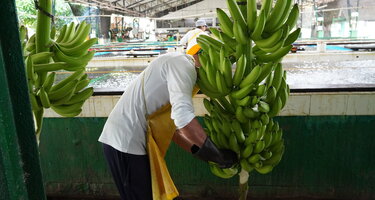Broader Wage Data Insights and Verification Across Multiple Sourcing Countries
As part of the German retail working group’s Banana Project, 2023 marked a significant expansion in the scope of wage data analysis. While the 2022 evaluation focused solely on Ecuador using 2021 data, the project has now extended its reach to additional focus countries.

In 2023, producers from 400 farms - representing a total of 41,596 employees - self-reported their 2022 wage data and uploaded it to the IDH platform. The analysis covered banana farms across Ecuador, Costa Rica, Colombia, the Dominican Republic, and Peru, providing a comprehensive overview of wage conditions in the sector.

On an aggregated level, 37.5% of employees (15,612 workers) were found to earn below the living wage, with an average living wage gap of 16.33% across all participating farms. However, the data also reveal that living wage gaps vary significantly between countries, reflecting differences in local wage structures, production conditions, and living wage benchmarks. A disaggregated analysis by gender further highlights disparities. Among male employees (36,497 workers), 36.3% earn below the living wage, with an average gap of 15.85%. Among female employees (5,099 workers), 46% fall below the living wage, facing a higher average gap of 19.39%.
Onsite Verifications to Ensure Data Quality
Following lessons learnt from previous wage data assessments which mostly relied on self-reported data and remote validations, onsite verifications were added as an integral project component to ensure the reliability and quality of the self-reported wage data. A total of 92 onsite verifications of the IDH Salary Matrix of 2022 were conducted by FLOCERT, an independent certification body, across sampled banana plantations. To streamline the process and reduce the verification burden for producers, GIZ aligned the sample selection closely with the other European retailer initiatives coordinated by IDH.
68% (63 plantations) received a positive verification result, confirming the accurate application of the IDH Salary Matrix and consistency of data. Of these farms, 60% showed a living wage gap for, on average, 50% of the workers, with an average gap of 17%. The remaining 32% (29 plantations) showed deviations, often due to errors in worker categorization, incorrect recording of overtime, and inclusion of non-applicable bonus. Of these farms with a negative result, 20% showed a living wage gap for, on average, 41% of the workers, with an average gap of 18%.
Key Insights and Recommendations
The verification exercise confirmed that most producers are able to apply the IDH Salary Matrix reliably but also highlighted the need for continued capacity building and technical support to ensure accurate data reporting across all farms.
FLOCERT and auditors recommended:
- strengthening training on living wage concepts and Salary Matrix use,
- harmonizing data collection systems to reduce manual entry errors, and
- exploring automated data quality checks to identify inconsistencies early.
Overall, the combination of expanded data collection, gender-sensitive analysis, and third-party verification provides a strong foundation for evidence-based action toward closing the living wage gap and promoting fair and sustainable income in the global banana supply chain. The insights gained will directly inform the ongoing development and further refinement of the Banana Project.
